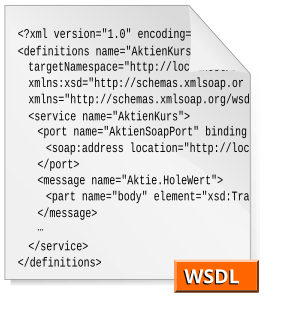
SOAP is a messaging protocol specification for exchanging structured information in the implementation of web services in computer networks. It uses XML Information Set for its message format, and relies on application layer protocols, most often Hypertext Transfer Protocol (HTTP), although some legacy systems communicate over Simple Mail Transfer Protocol (SMTP), for message negotiation and transmission.
The term Web service (WS) is either:
Web Services Security is an extension to SOAP to apply security to Web services. It is a member of the Web service specifications and was published by OASIS.
The Web Services Invocation Framework (WSIF) supports a simple and flexible Java API for invoking any Web Services Description Language (WSDL)-described service.
Web Services Discovery provides access to software systems over the Internet using standard protocols. In the most basic scenario there is a Web Service Provider that publishes a service and a Web Service Consumer that uses this service. Web Service Discovery is the process of finding suitable web services for a given task.

Apache Axis is an open-source, XML based Web service framework. It consists of a Java and a C++ implementation of the SOAP server, and various utilities and APIs for generating and deploying Web service applications. Using Apache Axis, developers can create interoperable, distributed computing applications. Axis development takes place under the auspices of the Apache Software Foundation.
XML Interface for Network Services (XINS) is an open-source technology for definition and implementation of internet applications, which enforces a specification-oriented approach.
The Jakarta XML Web Services is a Jakarta EE API for creating web services, particularly SOAP services. JAX-WS is one of the Java XML programming APIs.

Apache Axis2 is a web service engine. It is a complete re-design and re-write of the widely used Apache Axis SOAP stack. Implementations of Axis2 are available in Java and C.
Simple Soap Binding Profile is a specification from the Web Services Interoperability industry consortium. It is intended as a support profile for the WS-I Basic Profile.
webMethods Glue is an enterprise web services platform from webMethods. It provides web services/SOAP capabilities to existing Java and C/C++ applications.
Web Services Enhancements (WSE) is an obsolete add-on to the Microsoft .NET Framework, which includes a set of classes that implement additional WS-* web service specifications chiefly in areas such as security, reliable messaging, and sending attachments. Web services are business logic components which provide functionality via the Internet using standard protocols such as HTTP. Web services communicate via either SOAP or REST messages. WSE provides extensions to the SOAP protocol and allows the definition of custom security, reliable messaging, policy, etc. Developers can add these capabilities at design time using code or at deployment time through the use of a policy file.
Apache CXF is an open-source, fully featured Web services framework. It originated as the combination of two open-source projects: Celtix developed by IONA Technologies and XFire developed by a team hosted at Codehaus. These two projects were combined by people working together at the Apache Software Foundation and the new name CXF was derived by combining "Celtix" and "XFire".
Metro is an opensource web service stack that is a part of the GlassFish project, though it can also be used in a stand-alone configuration. Components of metro include JAXB RI, JAX-WS RI, SAAJ RI, StAX and WSIT. It is available under the CDDL and GPLv2

The Web Services Description Language is an XML-based interface description language that is used for describing the functionality offered by a web service. The acronym is also used for any specific WSDL description of a web service, which provides a machine-readable description of how the service can be called, what parameters it expects, and what data structures it returns. Therefore, its purpose is roughly similar to that of a type signature in a programming language.
SOA Repository Artifact Model & Protocol (S-RAMP) is a specification of SOA repository released by HP, IBM, Software AG, TIBCO, and Red Hat. The SOA repository provides environments for designing, running and monitoring services. The repository manages artifacts like schemas, service descriptions, business process definitions and policies. The SOA Repository Artifact Model and Protocol (S-RAMP) defines a common data model for SOA repositories as well as an interaction protocol to facilitate the use of common tooling and sharing of data. This ATOM binding specifications documents the syntax for interaction with a compliant repository for create, read, update, delete and query operations. The S-RAMP specification promotes interoperability of SOA Repositories. The S-RAMP specification is one of the SOA standards.
IBM WebSphere Service Registry and Repository (WSRR) is a service registry for use in a Service-oriented architecture.
gSOAP is a C and C++ software development toolkit for SOAP/XML web services and generic XML data bindings. Given a set of C/C++ type declarations, the compiler-based gSOAP tools generate serialization routines in source code for efficient XML serialization of the specified C and C++ data structures. Serialization takes zero-copy overhead.
Metro is a high-performance, extensible, easy-to-use web service stack and is a part of the GlassFish Application Server. Metro incorporates JAXB 2.x RI and JAX-WS 2.x Web services standards, along with other XML-related Java standards. Metro also includes added nonstandard components to support both basic JAX-WS service definition and usage and a variety of WS-* extensions to SOAP message exchange.